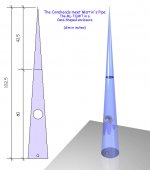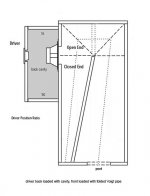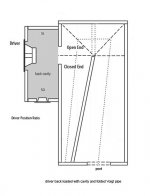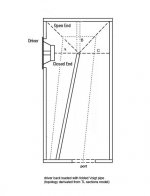Hi All,
How does the optimal/clasic TL look like of you combine a tapering TL (gradually reducing cross-section from woofer to mouth) with an offset (to create a helmholz resonance absorber if I may call it like that...)?
I mean is the tapering continued after/before the woofer into the 'head' cq helmholz resonance absorber or is the cross-section reduced or kept constant...
In ASCII ;-) (space replaced by dots)
A:
....../...|
...../....|
..../.....|
.../......|
..W.....|
./........|
---------
B:
....../...|
...../....|
..../.....|
.../......|
..W.....|
..\.......|
...------
C:
....../...|
...../....|
..../.....|
.../......|
..W.....|
..|.......|
..-------
Best regards,
Caratje
How does the optimal/clasic TL look like of you combine a tapering TL (gradually reducing cross-section from woofer to mouth) with an offset (to create a helmholz resonance absorber if I may call it like that...)?
I mean is the tapering continued after/before the woofer into the 'head' cq helmholz resonance absorber or is the cross-section reduced or kept constant...
In ASCII ;-) (space replaced by dots)
A:
....../...|
...../....|
..../.....|
.../......|
..W.....|
./........|
---------
B:
....../...|
...../....|
..../.....|
.../......|
..W.....|
..\.......|
...------
C:
....../...|
...../....|
..../.....|
.../......|
..W.....|
..|.......|
..-------
Best regards,
Caratje
MJK said:
OK, so lets say the drivers are located at 1/3 and 1/5 of the length. At the frequency of the 3/4 wavelength mode, which is probably around 150 Hz for a straight TL tuned to 50 Hz, the driver at 1/3 of the length will not see any influence on the back of the cone from the standing wave. The driver at 1/5 of the length will excite the 3/4 wavelength mode and will see a back pressure so its motion will be attenuated. The 3/4 mode in the enclosure is still excited, one driver will be playing unloaded as if it were in a baffle, and the the second driver will have an attenuated output typical of a TL.
This sounds right. Those two locations would be right on the nodes of the modes.
Scottmoose said:Hey, I like that Dave. Dunno how to go about building one, and it'd need a heck of a tall room, but I like it anyway! And as a bonus, you could hold a 16th century re-enactment in your living room if you got bored with listening to them
The top part is just to continue the lines, you could always truncate them.... Andy Graddon has a set half-done using a translam (but he gave up), i was thinking that a clever slice out of a sonotube might work.
dave
I found the article by Joe d'A on the design of Thor, and there he states: "using two midbass drivers exiting the line at slightly different points reduces mid-bass ripple". no explanation howeverMJK said:
I have not done the math or built such a system, but I guess I do not see any obvious significant attenuation of the ripple. In fact I would speculate (actually guess) that you could make a trade off between one and two drivers in a TL and find that neither configuration is free of problems. I don't see the ripple issue being much improved with two drivers. I am not sure I buy into the findings in Klang+Ton.
Henkjan said:I found the article by Joe d'A on the design of Thor, and there he states: "using two midbass drivers exiting the line at slightly different points reduces mid-bass ripple". no explanation however
He's just guessing....
dave
jackinnj said:I am surprised that no one on DIYAUDIO has commented on the exchange of letters in this month's AX.
Are you talking about mine & Paul K's vrs Rick Shultz? Or is there a newer issue?
dave
I think Dave and Paul said it all very well. Rick should have been a little more forthright in his referencing and more clearly acknowledged the work that MJK has done.
Good for Dave and Paul in rattling the cage a bit.
I would love to see an article written by Martin discussiong his work in AxP. He deserves the notariety.
Good for Dave and Paul in rattling the cage a bit.
I would love to see an article written by Martin discussiong his work in AxP. He deserves the notariety.
Amen to that. I've just read that article, I'm afraid it's a struggle for me to remain polite. As I prefer to keep a pleasent atmosphere on a public board, I'll refrain from writing exactly what I think and simply mention three general points.
Firstly, I thought Dave & Paul's letters were measured, detailed and well argued. Not that I'd expect anything else gents. The responses to these, especially the last, were so full of holes I'd laughing if it wasn't a serious matter.
Secondly, as I commented in a rant to Dave in a private email (sorry Dave!) if these Omega alignment tables are unique because they are the first time a QWR is derived from T/S parameters, exactly what, pray, is Martin's work? Random guesswork maybe?
Thirdly -if I tried to do something like this with my thesis, can you imagine what would happen? I'm not refering to speaker design here.
Best
Scott
Firstly, I thought Dave & Paul's letters were measured, detailed and well argued. Not that I'd expect anything else gents. The responses to these, especially the last, were so full of holes I'd laughing if it wasn't a serious matter.
Secondly, as I commented in a rant to Dave in a private email (sorry Dave!) if these Omega alignment tables are unique because they are the first time a QWR is derived from T/S parameters, exactly what, pray, is Martin's work? Random guesswork maybe?
Thirdly -if I tried to do something like this with my thesis, can you imagine what would happen? I'm not refering to speaker design here.
Best
Scott
I done some mods on the standard TL sections sheet
to simulate foded Voigt cabinet
seems that it works in praxis...
Practicly we have there back loaded, and front loaded systems,
(loaded with folded woigh horn)
The instinct tels me that it can be realy good
any comments...
to simulate foded Voigt cabinet
seems that it works in praxis...
Practicly we have there back loaded, and front loaded systems,
(loaded with folded woigh horn)
The instinct tels me that it can be realy good
any comments...
Attachments
- Status
- This old topic is closed. If you want to reopen this topic, contact a moderator using the "Report Post" button.
- Home
- Loudspeakers
- Full Range
- New version of Martin King's MathCad Worksheets is coming soon!



